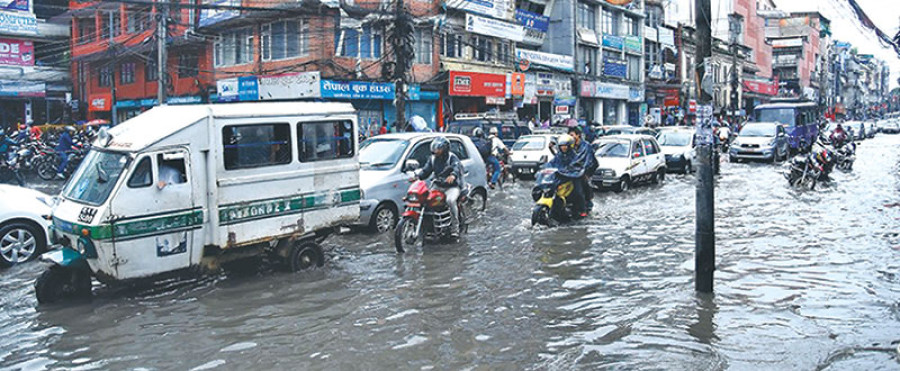Opinion
Deadly deluge
Harvesting flood waters and recharging Kathmandu’s depleting aquifers will turn a crisis into an opportunity
Navin Singh Khadka
Until not so long ago, floods sweeping people away was something people in Kathmandu knew as incidents that happened in other parts of the country. Human settlements and farms marooned by rivers that breached their embankments during monsoon was a typical feature of the Tarai only. They sometimes also heard about people and houses in mountain regions swept away by unsuspected rivers and rivulets. All these were disasters that happened somewhere far away from them and they could witness the extent of the damages on TV screens from the luxury of their homes. But now their own houses and streets are deluged—welcome to the Capital of puddles, potholes and sinkholes.
A video of a school girl who fell into a pit that had become invisible due to floods in the Capital’s roads went viral last week. The visual is nerve-racking as the girl disappears after the fall but is quickly rescued a few metres downstream. Another girl, in a separate incident, was not so lucky. Found after being swept away by flood waters, she was taken for treatment, but did not survive.
Getting worse
Believe it or not, this is Kathmandu today. And from what is happening, both locally and globally, it’s only going to get worse. Of course, even planned cities in developed countries see some areas deluged as incidents of extreme rainfall are on the rise worldwide. “Urban pluvial (surface) flood risk is expected to increase significantly in the future as a result of climate changes and demographic shifts,” says a study by Imperial College London. “The former is likely to increase the magnitude and frequency of extreme storm events, the driving force of pluvial flooding, while the latter will increase exposure and hence, risk.”
In Kathmandu’s case, as of now, it is more about the people and how they have messed up with the city’s carrying capacity and its natural flood defence systems.
A combination of unregulated urbanisation, population boom and a disregard of natural systems has brought us to this precarious point. A thriving real estate industry made us believe it was smart to cover the “tukuchaas”—the natural drains snaking through different parts of the
capital—and build houses on and near them. We are already experiencing the repercussions of doing so.
Global examples
There are many examples across the globe of how and why not to do it. One of the recent ones was in Chennai, a metropolitan city in southern India that remained marooned for weeks in 2015. The main reason was that almost all wetlands in and around it had been gobbled up by the ever expanding cityscapes. Chennai municipality said more than 300 tanks, canals and lakes had disappeared over the past 20 years. It also found that there were more than 150,000 illegal structures. This despite a master plan prepared in 2008.
“An information technology park in Chennai is flooded because it is located at a place where waters from two separate lakes converge and flow to a neighbouring creek,” Nityanand Jayaraman, a Chennai-based social activist, wrote for the BBC. “Many of the city’s info-tech facilities are built on marshlands, water-bodies and water courses. The disconnect with nature is also manifest in the failure of planners, builders, administrators and even common people to fathom the sheer power of natural events.”
Four years earlier, another Asian city faced an even worse water-disaster. Protecting Bangkok became mission impossible for the Thai government as the country saw one of the deadliest floods in decades. Sluice gates into the capital had to be opened as water levels to the north reached a very dangerous point, threatening the flood barriers. More than 800 people died and property worth nearly $50 billion was lost.
While other Southeast Asian cities are increasingly facing the same fate in recent years, Chinese cities in particular are water-logged almost every rainy season despite their new infrastructures.
“China’s urban sprawl has been expanding much faster than its drainage infrastructure could catch up,” the Economist wrote in 2015. “Most drains cannot cope with the sort of rainfalls that has a 100 percent chance of occurring in any given year,” it quoted Zhou Yuwen, a professor of civil engineering at the Beijing University of Technology, as saying.
If you are thinking countries with coastal cities are different from what Kathmandu is faced with, you have a point. Yes, the Capital will not have to worry about tidal and sea storm-induced floods. But landlocked countries are not free from risks of inundation. Take Zimbabwe, for instance. This landlocked east African country’s capital Harare is dotted with potholes even as most of its roads are asphalt paved.
“The city’s asphalt road network is in dire straits, and will only get worse as damage from flooding and freak weather increases due to the impact of climate change,” Reuters Thompson Foundation reported this week. “The solution—say engineers, city planners and campaigners—is concrete roads.”
That idea is largely based on the experience of other African countries including Malawi, Ethiopia and South Africa.
But concrete roads are much more expensive than asphalt and tarmac ones.
Big ifs
Nepal, and Kathmandu in particular, will obviously opt for the cheaper option for now. But even if it went for a costlier choice, it will not be a foolproof measure. “The likelihood (i.e. hazard) of pluvial flooding occurring is higher in urban areas due to the high proportion of tarmacked and paved surfaces, which limit water infiltration and increase the amount of water running off the ground surface as well as its speed,” says the Imperial College London study.
The bad news for places like Kathmandu is that urban flooding, particularly in regard to climate change, is often recognised in the context of coastal cities.
What that means is the scientific community will mostly focus on the solution for such cities.
That presents additional challenges for our city planners and policymakers—if at all they become serious about these problems. If they learn to preserve natural sponges like wetlands including ponds, “tukuchaas”, creeks, and vegetation, half the battle will be won. And if they take initiatives to harvest flood waters and recharge the fast depleting aquifers of Kathmandu, it will be turning the crisis into an opportunity. But given the craze for concrete in the name of development and infrastructure building these remain big ifs.
Khadka is a BBC journalist based in London




 7.12°C Kathmandu
7.12°C Kathmandu










